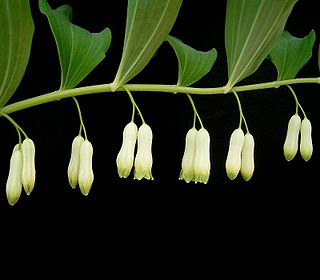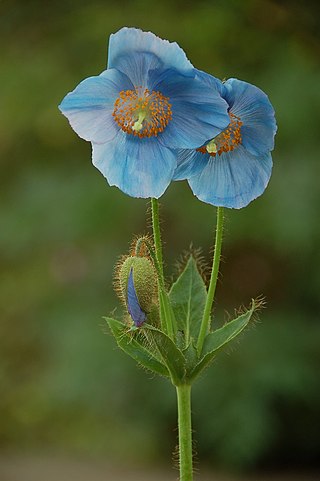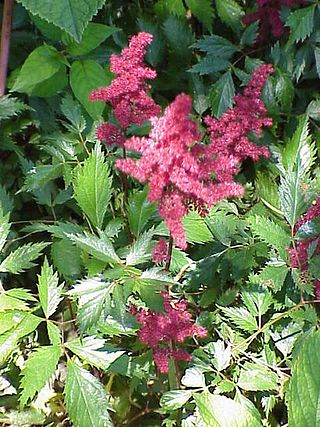
Gentiana is a genus of flowering plants belonging to the gentian family (Gentianaceae), the tribe Gentianeae, and the monophyletic subtribe Gentianinae. With over 300 species, it is considered a large genus. Gentians are notable for their mostly large trumpet-shaped flowers, which are often of an intense blue hue.

Polygonatum, also known as King Solomon's-seal or Solomon's seal, is a genus of flowering plants. In the APG III classification system, it is placed in the family Asparagaceae, subfamily Nolinoideae. It has also been classified in the former family Convallariaceae and, like many lilioid monocots, was formerly classified in the lily family, Liliaceae. The genus is distributed throughout the temperate Northern Hemisphere. Most of the approximately 63 species occur in Asia, with 20 endemic to China.

Androsace, commonly known as rock jasmine, is a genus of flowering plants in the family Primulaceae, second only to Primula in the number of species. It is predominantly Arctic–alpine, with many species in the Himalayas, the mountains of central Asia, the Caucasus, and the southern and central European mountain systems, particularly the Alps and the Pyrenees.

Chrysosplenium is a genus of flowering plants in the family Saxifragaceae. It includes 84 species found throughout the Arctic and northern temperate parts of the Northern Hemisphere. The highest species diversity in eastern Asia, and two species are found disjunctly in northern South America.

Meconopsis is a genus of flowering plants in the poppy family Papaveraceae. It was created by French botanist Viguier in 1814 for the species known by the common name Welsh poppy, which Carl Linnaeus had described as Papaver cambricum. The genus name means "poppy-like". Himalayan species discovered later were also placed in Meconopsis. In the 21st century, it was discovered that the Himalayan species were less closely related to the Welsh poppy, which has been restored to Papaver. All species now placed in Meconopsis are native to the Himalayas and surrounding regions. They have attractive, usually blue flowers.

Astilbe is a genus of 18 species of rhizomatous flowering plants within the family Saxifragaceae, native to mountain ravines and woodlands in Asia and North America. Some species are known by the common names false goat's beard and false spirea.

Draba is a large genus of flowering plants in the family Brassicaceae, commonly known as whitlow-grasses.

Isopyrum is a genus of flowering plants of the family Ranunculaceae native to Eurasia. The North American genus Enemion is sometimes treated as part of it.

Daphniphyllum is the sole genus in the flowering plant family Daphniphyllaceae and was described as a genus in 1826. The genus includes evergreen shrubs and trees mainly native to east and southeast Asia, but also found in the Indian Subcontinent and New Guinea.

Caragana is a genus of about 80–100 species of flowering plants in the family Fabaceae, native to Asia and eastern Europe.

Arachniodes is a fern genus in the family Dryopteridaceae, subfamily Dryopteridoideae, in the Pteridophyte Phylogeny Group classification of 2016. A number of species in this genus are known as "holly ferns".

Diarrhena, or beakgrain, is a genus of Asian and North American plants in the grass family.

Micranthes is a genus of flowering plants in the saxifrage family. It was formerly included within the genus Saxifraga until recent DNA evidence showed the members of what is now Micranthes are more closely related to Boykinia and Heuchera than to other members of the genus Saxifraga.

Eritrichium is a genus of flowering plants in the family Boraginaceae. It contains 78 species. Notable members include Eritrichium howardii and Eritrichium nanum.
Dichocarpum is a genus of flowering plants belonging to the family Ranunculaceae.
Odontostemma is a genus of flowering plants in the carnation family, Caryophyllaceae. It includes 61 species native to the Himalayas and Tibetan Plateau, including parts of India, Pakistan, Nepal, Bhutan, Myanmar, and China.














